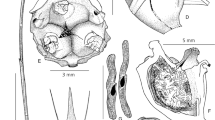Summary
A new species of Barleria (Acanthaceae), discovered in 2014 on the Uzondo Plateau of West Tanzania, is described and illustrated and its affinities are discussed. This is the first documented tree species in the genus Barleria. Its conservation status is assessed using the categories and criteria of IUCN; it is considered to be globally Vulnerable.


Similar content being viewed by others
References
Baden, C. (1981). The genus Anisotes (Acanthaceae), a taxonomic revision. Nord. J. Bot. 1: 623 – 664.
Balkwill, M. J. & Balkwill, K. (1997). Delimitation and infra-generic classification of Barleria (Acanthaceae). Kew Bull. 52: 535 – 573.
Brinkhoff, T. (2015). City Population, http://www.citypopulation.de. Accessed 8th July 2015.
Crawford, F. M., Darbyshire, I. & Vollesen, K. (2016). Tephrosia uzondoensis (Leguminosae: Papilionoideae): a new species and possible endemic to the Uzondo Plateau of Tanzania. Kew Bull. 71. DOI 10.1007/S12225-016-9621-1
Daniel, T. F. (1988). A systematic study of Bravaisia DC. (Acanthaceae). Proc. Calif. Acad. Sci. 45: 111 – 132.
Darbyshire, I. (2010). Barleria. In: H. J. Beentje (ed.), Flora of Tropical East Africa. Acanthaceae (Part 2), pp. 325 – 442. Royal Botanic Gardens, Kew.
____ & Ndangalasi, H. J. (2009). Three new species of Barleria sect. Somalia (Acanthaceae) from the miombo woodlands of western Tanzania. J. E. African Nat. Hist. 97: 123 – 134.
IUCN (2012). IUCN Red List Categories and Criteria. Version 3.1. Second Edition. IUCN Species Survival Commission, Gland.
Luke, Q., Bangirinama, F., Beentje, H. J., Darbyshire, I., Gereau, R., Kabuye, C., Kalema, J., Kelbessa, E., Minani, V., Mwangoka, M. & Ndangalasi, H. (2015a). Barleria aenea. The IUCN Red List of Threatened Species. http://dx.doi.org/10.2305/IUCN.UK.2015-2.RLTS.T48153949A48154213.en. Accessed 8 February 2016.
____, ____, ____, ____, ____, ____, ____, ____, ____, ____, & ____ (2015b). Anisosepalum lewallei. The IUCN Red List of Threatened Species. http://dx.doi.org/10.2305/IUCN.UK.2015-2.RLTS.T48153846A48154145.en. Accessed 8 February 2016.
Manning, J. C. & Getliffe-Norris, F. M. (1995). Duvernoia. In: O. A. Leistner (ed.), Flora of Southern Africa, Part 3: Acanthaceae, Fascicle 1: Justiciinae, vol. 30, pp. 15 – 17. National Botanical Institute, Pretoria.
Obermeijer, A. A. (1933). A revision of the South African species of Barleria. Ann. Transvaal Mus. 15: 123 – 180.
Schwarzbach, A. E. & McDade, L. A. (2002). Phylogenetic relationships of the mangrove family Avicenniaceae based on chloroplast and nuclear ribosomal DNA sequences. Syst. Bot. 27: 84 – 98.
Tripp, E. A., Daniel, T. F., Fatimah, S. & McDade, L. A. (2013). Phylogenetic relationships within Ruellieae (Acanthaceae) and a revised classification. Int. J. Pl. Sci. 174: 97 – 137.
Vollesen, K. (2002). Three new species of Blepharis (Acanthaceae). Kew Bull. 57: 451 – 457.
____ (2008). Anisosepalum. In: H. J. Beentje & S. A. Ghazanfar (eds), Flora of Tropical East Africa, Acanthaceae (Part 1), pp. 21 – 24. Royal Botanic Gardens, Kew.
____ (2010). Anisotes. In: H. J. Beentje (ed.), Flora of Tropical East Africa. Acanthaceae (Part 2), pp. 651 – 663. Royal Botanic Gardens, Kew.
Acknowledgements
The authors are grateful to The Tanzania Commission for Science and Technology (COSTECH) for granting the Research Clearances which allowed the collecting trips in 2014 to be carried out. Maria Vorontosova is thanked for her field collaboration; funding for fieldwork in western Tanzania was granted by the Kew Herbarium Fieldwork Fund. Itambo Malombe (EA) is thanked for facilitating the loan of the type material to Kew. The authors are particularly grateful to Andrew Brown for the detailed illustration of the new species. We also thank Kaj Vollesen for providing helpful information on the type locality and its flora.
Author information
Authors and Affiliations
Corresponding author
Rights and permissions
About this article
Cite this article
Darbyshire, I., Luke, Q. Barleria mirabilis (Acanthaceae): a remarkable new tree species from west Tanzania. Kew Bull 71, 13 (2016). https://doi.org/10.1007/s12225-016-9622-0
Accepted:
Published:
DOI: https://doi.org/10.1007/s12225-016-9622-0




